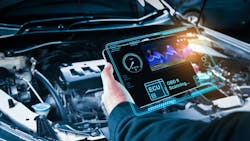AI has begun to play a new role in the automotive industry, from monitoring tires to managing fleets. All the same, how this technology will continue to develop, and what role it could play for commercial vehicles, is an open question.
An AAPEX webinar, led by Predii Founder and CEO Tilak Kasturi and Vice President of Sales and Business Development Mark Seng, dives straight into how it can be best used and what its introduction into the industry will look like.
Read more: Using AI to combat data overload
How can AI be used in the automotive field?
Seng points out that while most people use AI in their day-to-day lives, the way it functions in the automotive industry will look a little different. Similar to how AI is meant to mimic a human, an AI for the auto industry would be built to function as a service advisor.
Seng uses the example of a driver telling an AI system that he is unable to call someone on the phone while driving. An AI system specialized in automotive issues could pick up on the phrases “call” and “driving” and suggest a Bluetooth error.
Even though shops that have been in operation for a few years have likely seen a multitude of different problems and scenarios come through their doors, every diagnosis and solution is not remembered by technicians.
AI can be used to leverage historical data from past repair orders and can even be used to help bring inexperienced technicians up to speed with new kinds of jobs. As vehicles become more complex, AI can be a useful tool to train new staff.
Shops frequently experience customers who are inclined to put off maintenance. If a customer agrees to share TeleDiagnostic data with the shop, the shop can provide a more accurate picture of the state their vehicle is in and will have personalized data from the vehicle itself when it’s time to perform maintenance.
In such a case, it could be possible for a driver to be unaware of a potential issue with their vehicle while the AI picks up diagnostic codes that communicate problems to a shop before any warning lights appear on the vehicle’s dashboard.
While consumers are often concerned about having extra work performed on their vehicles, a shop being able to provide data on the issue can help the customer feel more confident in their choice.
It also helps a shop prepare itself before the problem becomes worse. If an issue is detected and communicated to the shop through AI, any parts or supplies needed can be ordered before the customer even walks into the store.
How does it work, and how will it unfold?
Katsuri opens his half of the presentation by explaining generative AI as an AI system that can generate original content based on data and that improves as it gains feedback and responses.
While generative AI has been able to demonstrate success in the lack of sufficient data, inaccurate, contradictory, and sometimes flatly false responses can also be generated. This can be useful for tasks such as creating images or audio, but in a technical field like automotive repair, precautions must be taken to avoid this.
The type of AI in the automotive industry would be able to intelligently answer and respond to questions through the simultaneous use of different data and sources of knowledge that will be applied to a specific make and model of a vehicle.
Though the use of AI in the auto industry has been studied for years, programs such as ChatGPT have only been around for a little under a year, and it’s a technology that is steadily evolving. As it unfolds in the auto industry specifically, it will likely take place through four stages.
The first immediate stage will involve AI being introduced to an organization, mainly in applicable workflow tasks.
The second stage looks at the short-term implementation of AI, which will have trials of organizations experimenting with different AI systems to find one that will keep the questions received and answers generated by the organization’s system safe and secure.
In the mid-term, organizations and businesses can gather enough data from AI that can be used to improve workflows and applications, and for an organization to even create its own generative AI.
Long-term, automotive AI will be brought to the consumer, providing personalized data and services unique to them and their vehicle’s needs.
However, for AI to be used in the industry to its full capabilities, regulations and standards are essential. Industry leaders such as the Auto Care Association and the Automotive Service Association have become involved in discussions surrounding AI’s use in the field for precisely this reason.
The path toward AI being used in the auto industry is undoubtedly still a long one. But with it already being used in many segments, such as AI-generated estimates for collision repair, it may be in a business’s best interest to learn how to leverage it for their work.
This article was originally published on VehicleServicePros.com.
About the Author

Kacey Frederick
Kacey Frederick is an assistant editor for Endeavor Business Media's Vehicle Repair Group. Frederick covers innovations and trends in the automotive industry.
